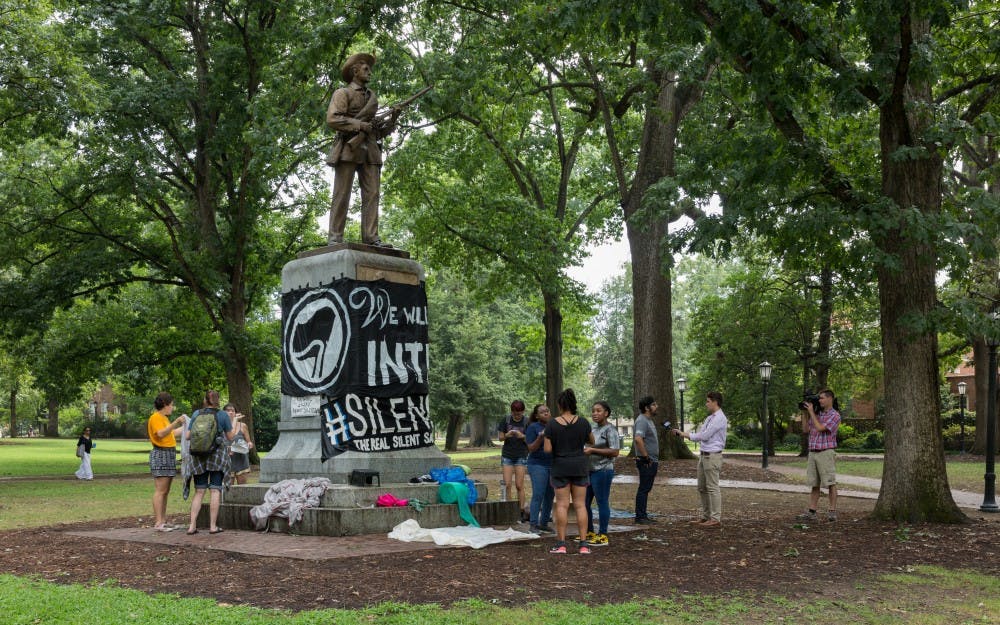On Monday, the UNC-Chapel Hill Board of Trustees proposed the creation of a multi-million-dollar facility to house Silent Sam—the confederate statue on campus that students toppled in August. In addition to the staggering cost of constructing the building itself, the operating costs are estimated to hover around $800,000 annually. This announcement sparked the latest wave of student protests on the UNC-Chapel Hill campus. Monday night, hundreds gathered in opposition. Two students were arrested following demonstrations—one of whom was Maya Little, a graduate student and vocal leader in the movement to remove Silent Sam. As the week has progressed, activists have continued to express disapproval and called for teaching assistants and faculty to withhold grading in protest.
Duke has been forced to reckon with its history as well this semester. Just like our Tarheel neighbors, students and faculty have organized to interrogate how the university chooses to memorialize or hide annals of history. A week ago, after months of pressure, the Board of Trustees has finally voted to remove “Carr” from the East Campus building housing the History Department. The namesake of which is Julian Carr, an industrialist and well-documented white supremacist. In contrast with Duke’s relatively quick decision amid student protests and an official request filed by History faculty, this proposal for Silent Sam is prolonging an expensive, ill-conceived fight for a monument to white supremacy.
The history of Silent Sam began over a century ago when the UNC Board of Trustees approved a 1908 request by the United Daughters of the Confederacy to establish a monument to Chapel Hill men who left their studies to fight for the South in the Civil War. The primary cause of this neo-confederate organization, since its founding in 1894, has been to peddle ahistorical, romanticized versions of the Antebellum South and establish monuments to Confederate soldiers. While the UDC claim these statues and monuments are merely benign symbols of veteran remembrance, the periods of high construction rates correspond clearly with epochs of elevated tension around racial civil rights. This correlation rings true for the memorial currently at the center of the fight being played out in Chapel Hill.
The historical tendons that connect Silent Sam and white supremacy are further emphasized given Julian Carr’s infamous 1913 dedication at its unveiling. In the speech, he called the Confederates saviors “of the Anglo Saxon race in the South” and boasted of “horse-whipp[ing] a negro wench until her skirts hung in shreds.”
The case for acknowledging Silent Sam as a symbol of violence and anti-blackness rather than a neutral historical artifact is a strong one. Testimonies by black students, alumni, faculty and community members further cement the harmful impact this statue has through its presence on campus.
In light of this, the fact that UNC-Chapel Hill trustees would choose to allocate $5.3 million to a new facility for the statue is beyond reprehensible. Silent Sam has always been imbued with white supremacy and has only become a more virulent icon of local fascist and neo-confederate footholds.
Framing the center as educational is more nefarious than an attempt to protect the monument as a symbol of historical significance. It is a clear message that the safety and comfort of black UNC students, workers and faculty matter less than a statue.
In the past year, Silent Sam has become a new chess piece in a larger culture war struggle that stretches far beyond the Research Triangle. By continuing to protect and maintain the statue’s presence on the Chapel Hill campus, UNC is providing both legitimacy to the racist rhetoric of white supremacists and a rallying site for their many organizations. Regardless of whether Silent Sam is replaced in the original location or housed across campus, UNC-Chapel Hill cannot divorce the statue from its historical genesis in racism and slavery apologism.
In many ways the prioritization of Silent Sam is parallel to broader lineages of assignments of human worth in America. The fact that the Board of Trustees is willing to appropriate millions to shelter an inanimate casting of a Confederate soldier while there is considerable food insecurity among undergraduates and Latinx students lack a permanent space for community gatherings, is part of a long history of white bodies—or even symbols of them, in this case—meaning more than black, brown and poor bodies.
Ultimately, the 2015 law that has complicated Silent Sam’s future needs to be abolished; the statue has no place on the pedestal or in a multi-million dollar shrine. The more the state legislature continues to protect archaic remnants of the past by any means necessary, the more troubling the future of North Carolina and UNC-Chapel Hill becomes.
This was written by The Chronicle's Editorial Board, which is made up of student members from across the University and is independent of the editorial staff.
Get The Chronicle straight to your inbox
Signup for our weekly newsletter. Cancel at any time.

